TL;DR
In October 2025, the U.S. entered a monetary easing cycle, with the Federal Reserve cutting interest rates and pausing balance sheet reduction. However, economic recovery remains weak, affected by high inflation, a sluggish job market, low consumer confidence, and intertwined government and external risks impacting growth. Although inflation has eased somewhat, it remains above target, and weak employment and fiscal constraints have diminished the short-term stimulative effects of easing policies. Overall, the U.S. is in the early stages of a loosening cycle, with an improved policy environment, but uncertainties regarding inflation, employment, and external risks continue to pressure economic recovery.
The crypto market experienced significant volatility in October, with trading volume surging to $428.2 billion during the "10·11" crash, marking a monthly peak. Afterward, trading became subdued, with weak liquidity and declining risk appetite. The overall market capitalization slightly fell by 0.57% compared to the previous month, maintaining fluctuations after a sharp pullback, with cautious market sentiment and insufficient incremental funds. Newly launched tokens primarily focused on infrastructure, DeFi, and AI projects, while Chinese meme coins gained short-term popularity but showed limited sustainability.
In October, Bitcoin and Ethereum spot ETFs saw net inflows of $5.55 billion and $1.01 billion, respectively, with market confidence recovering somewhat after the black swan event, though overall sentiment remained cautious. The total circulation of stablecoins increased by $9.38 billion, with USDT and USDC being the main sources of growth, while USDE saw a significant decline in circulation by 31.1% due to the de-pegging event.
Bitcoin's short-term momentum has weakened, with prices failing to stabilize above the 50-day SMA, currently fluctuating near the 20-day EMA. A drop below the $107,000 support could accelerate a decline to $100,000, while $118,000 remains a key resistance level. Ethereum appears weak overall, with prices retreating below the 50-day SMA; a break below the descending triangle support could lead to further declines to $3,350. If it regains the 50-day SMA, bulls may push for a rebound, but resistance remains strong. Solana shows clear back-and-forth trading, failing to stabilize above the 20-day EMA; a breakout and stabilization above could lead to an upward move to the channel resistance line, while a drop below $190 would favor bears, potentially pulling back to $177 or even testing the lower channel boundary.
October saw the largest liquidation in crypto market history, with Bitcoin, Ethereum, and altcoins plummeting due to Trump tariffs and the USDe de-pegging event. The total liquidation amount reached a new high of $19.1 billion, indicating systemic leverage risk exposure. Chinese meme coins rapidly gained popularity on Binance and within the Solana and Base ecosystems, with projects like "Binance Life" experiencing a short-term market cap surge and attracting many new traders, becoming a phenomenon. The launch of the x402 protocol drew market attention, with related project prices soaring temporarily before retreating, indicating concentrated and volatile interest in innovative concepts.
Next month, the prediction market is expected to continue accelerating expansion, with projects like Polymarket, Kalshi, and Truth Predict driving increased industry liquidity and attention, while capital and public chain ecosystem layouts are also accelerating. Although the crypto market suffered structural damage after the October 11 black swan event, expectations of trade easing and favorable policies provide support for the short-term return of risk assets. Future focus should be on the performance of new prediction market projects, progress in U.S.-China trade, changes in the dollar and liquidity environment, and leverage risks in the crypto market.
1. Macroeconomic Perspective
In October 2025, the U.S. economy entered a loosening cycle, but recovery momentum remains weak. The Federal Reserve has continuously cut interest rates and will pause balance sheet reduction, shifting policy focus from suppressing inflation to stabilizing growth and preserving employment, reflecting concerns over economic slowdown. Inflation remains high, the job market continues to be sluggish, consumer confidence is declining, and government shutdowns and external risks are intertwined, resulting in a state of "policy has loosened, growth has not yet taken off." Overall, the U.S. is at an early turning point in the cycle, with an improved policy environment, but macroeconomic recovery still requires time.
Policy Shift
In October, the Federal Reserve cut interest rates by another 25 basis points, lowering the federal funds rate to a range of 3.75%–4.00%, and announced a pause in balance sheet reduction to release liquidity and strengthen the effects of easing. This marks a comprehensive shift in monetary policy towards growth orientation. The current decision-making logic emphasizes prioritizing growth, with the Fed believing that inflation risks are relatively controllable, while worsening employment and fiscal uncertainty pose more urgent challenges. The market expects another rate cut may occur within the year, but policy transmission will still take time, making it difficult to quickly stimulate consumer and business investment in the short term.
Inflation Still Above Target
In September, the CPI rose by 3.0% year-on-year, with core CPI also at 3.0%. Although this is below expectations, it remains above the Fed's 2% target. Prices for food, housing, and services continue to rise, indicating that endogenous inflation has not fully dissipated. Powell emphasized in a statement that while inflation is trending towards moderation, policies cannot relax vigilance too early. If inflation declines at a slower pace, the Fed may delay further easing. Inflation is temporarily controllable, but the target range has not yet been achieved.
Job Market Further Weakens
The rapid cooling of the labor market has become a core inducement for this round of easing. Due to the U.S. government shutdown, the Bureau of Labor Statistics has suspended the release of September non-farm employment data, leaving the market lacking key references. The latest available data from August shows a significant slowdown in job growth, with only 22,000 new positions added. Additionally, June data was revised down to negative growth. The weak labor market is undermining support for consumption and the service sector, exacerbating the deterioration of household income expectations. The market is generally concerned that if employment continues to worsen, the economy will fall into a deeper growth decline, forcing the Fed to adopt more aggressive easing measures.
Political, Fiscal, and External Risks Persist
The U.S. government has shut down due to budget impasses, with some departments halting pay and operations, weakening fiscal spending and data transparency. Ongoing geopolitical frictions, including tensions in the Middle East and U.S.-China technology conflicts, increase risk premiums. Fiscal and external uncertainties weaken the marginal effectiveness of monetary easing, making the pace of market recovery more sluggish. While easing provides short-term support, the transmission channels for policies are obstructed, and corporate confidence and long-term investment recovery remain limited.
Outlook
The U.S. is in the early stages of a loosening cycle, with an improved policy environment, but economic recovery has not yet stabilized. Future focus will be on whether inflation can continue to decline, whether employment can stabilize, and whether easing policies can effectively transmit to consumption and investment. The fiscal deadlock, geopolitical risks, and market confidence remain major uncertainties.
2. Overview of the Crypto Market
Currency Data Analysis
Trading Volume & Daily Growth Rate
According to CoinGecko data, as of October 27, the overall trading volume in the crypto market has shown significant fluctuations. During the "10·11" crash, market sentiment surged sharply, with trading volume soaring to $428.2 billion, a 106% increase month-on-month, reaching a monthly peak, as funds were released in panic and speculation. Outside of this period, overall market trading has been relatively subdued, with trading volume mostly maintained in the $150 billion to $200 billion range, indicating a decline in investor risk appetite and a cautious sentiment. The liquidity appears slightly weak, with the market lacking sustained incremental funds entering, and in the short term, stronger upward momentum will require macro and policy favorable factors to drive recovery.

Total Market Capitalization & Daily Growth Amount
According to CoinGecko data, as of October 27, the total market capitalization of cryptocurrencies was $3.94 trillion, down 0.57% from the previous month. From the beginning of the month to October 9, the total crypto market capitalization continued to rise slightly, increasing from $3.96 trillion to $4.32 trillion, reflecting a gradual return of funds under phase-specific favorable conditions. However, from October 10 to 11, the market experienced a sudden downturn, with a daily decline exceeding 9%, marking the largest pullback of the month, indicating panic selling of funds during the "10·11" market. Although the market briefly rebounded afterward, rising about 5.7%, the overall rebound strength was limited, with market capitalization fluctuating between $3.7 trillion and $3.9 trillion. Overall, the market has stabilized after experiencing sharp adjustments, with increased cautious sentiment among funds and insufficient willingness for incremental funds to enter, remaining in a fluctuating phase.
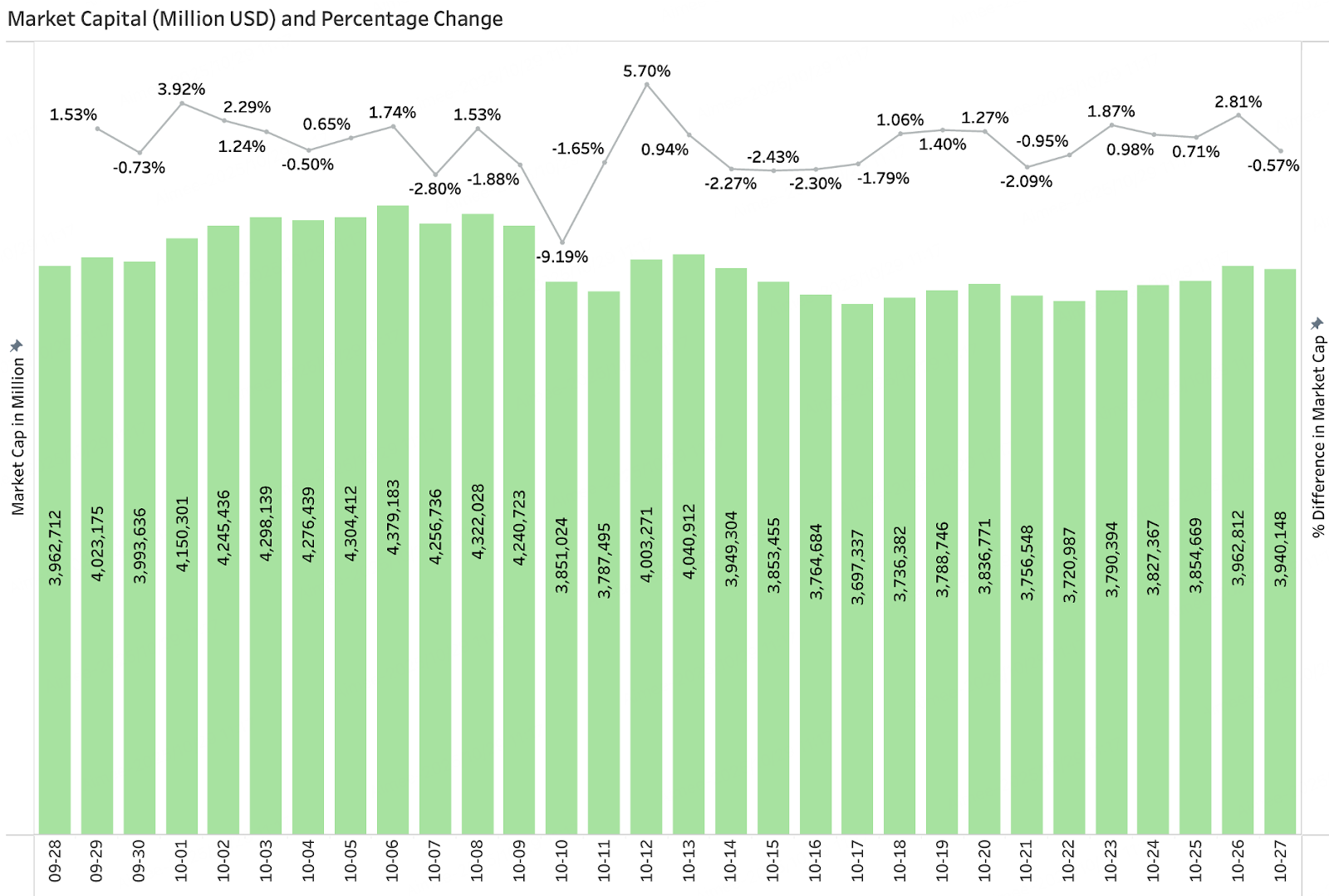
Newly Launched Popular Tokens in October
The popular tokens launched in October primarily focused on infrastructure, DeFi, and AI sectors, with a continued emphasis on VC-backed projects. Notable projects include Enso, Recall, Falcon Finance, YieldBasis, and ZEROBASE, which performed well and saw active trading after launch. Additionally, the Chinese meme sector gained short-term traction due to the "Binance Life" effect and CZ's endorsements, with the launch of Binance contracts further fueling its sentiment.
Token Fullname
Token
CoinGecko/CoinMarketCap
Exchange
DoubleZero
2Z
https://coinmarketcap.com/currencies/doublezero/
Bitmart, Binance, Bybit, Gate, Coinbase, Bitget, Crypto.com, Kucoin, Mexc, Lbank, Phemex
Falcon Finance
FF
https://coinmarketcap.com/currencies/falcon-finance-ff/
Bitmart, Binance, Bybit, Gate, Bitget, Huobi, Kraken, Kucoin, Mexc, Lbank, Phemex
Meteora
MET
https://coinmarketcap.com/currencies/meteora/
Bitmart, OKX, Bybit, Gate, Coinbase, Bitget, Crypto.com, Huobi, Kucoin, Mexc, Lbank, Phemex
Anoma
XAN
https://coinmarketcap.com/currencies/anoma/
Bitmart, Bybit, Gate, Coinbase, Crypto.com, Huobi, Kraken, Kucoin, Mexc, Phemex
Recall
RECALL
https://coinmarketcap.com/currencies/recall-network/
Bitmart, Bybit, Gate, Coinbase, Bitget, Kucoin, Mexc, Lbank, Phemex
Nomina
NOM
https://coinmarketcap.com/currencies/nomina/
Bitmart, Binance, Bybit, Gate, Bitget, Crypto.com, Huobi, Kucoin, Mexc, Lbank, Phemex
YieldBasis
YB
https://coinmarketcap.com/currencies/yieldbasis/
Bitmart, Binance, OKX, Bybit, Gate, Coinbase, Bitget, Kraken, Kucoin, Mexc, Lbank, Phemex
ZEROBASE
ZBT
https://coinmarketcap.com/currencies/zerobase/
Bitmart, Binance, Bybit, Gate, Bitget, Huobi, Kraken, Kucoin, Mexc, Lbank, Phemex
COMMON
COMMON
https://coinmarketcap.com/currencies/common/
Bitmart, Bybit, Gate, Bitget, Kucoin, Mexc, Phemex
Enso
ENSO
https://coinmarketcap.com/currencies/enso/
Bitmart, Binance, Bybit, Gate, Bitget, Kraken, Kucoin, Mexc, Lbank, Phemex
3. On-Chain Data Analysis
Analysis of BTC and ETH ETF Inflows and Outflows
October BTC Spot ETF Net Inflow of $5.55 Billion
In October, Bitcoin spot ETFs continued the trend of capital inflows, with a monthly net inflow of $5.55 billion, bringing total assets to $149.9 billion, a month-on-month increase of 3.8%. Bitcoin's price slightly rose from $108,936 at the end of September to $110,070, an increase of 1%. The crypto market has seen some improvement in confidence following the black swan event on October 11, but overall changes remain minimal, still in a sluggish environment.
October ETH Spot ETF Net Inflow of $1.01 Billion
Ethereum spot ETFs recorded a net inflow of approximately $1.01 billion in October, increasing total assets to $26.6 billion, a month-on-month increase of 3.9%. The price of ETH rose from $3,839 to $3,904, an increase of 1.69%.

Analysis of Stablecoin Inflows and Outflows
October Stablecoin Total Circulation Increased by $9.38 Billion
Although the overall stablecoin market remained in an inflow state and continued to grow in October, market confidence was severely impacted by the black swan event on October 11. Notably, USDE saw a significant decline in circulation by nearly 31.1% due to its price de-pegging during the black swan event, raising doubts about its algorithmic stablecoin mechanism. On the other hand, the total circulation of stablecoins increased by $9.38 billion, reaching $281.25 billion. USDT saw a monthly increase of $10.15 billion, maintaining its leading position. USDC (+$2.23 billion) also became a major source of growth.
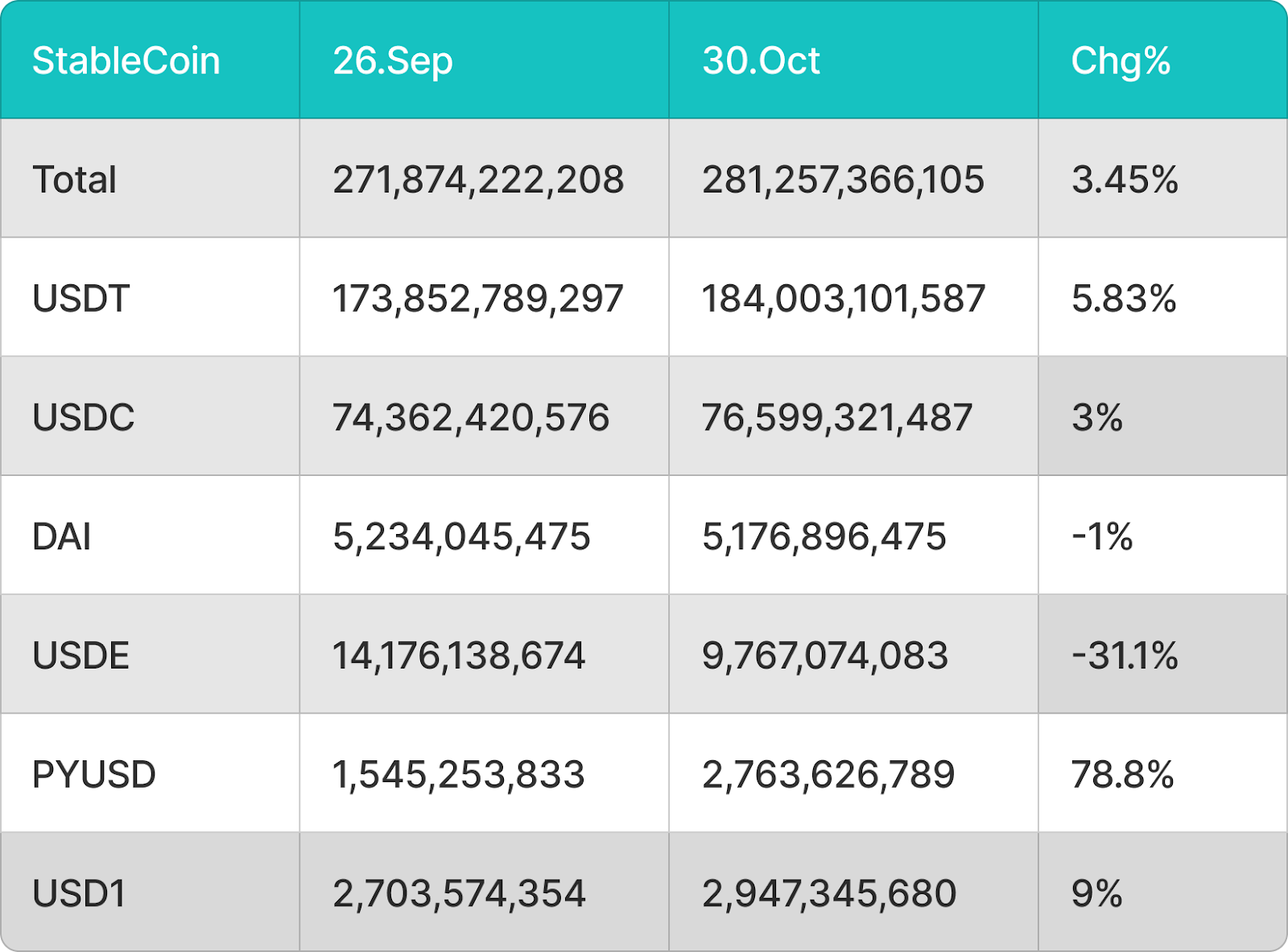
4. Price Analysis of Major Currencies
BTC Price Change Analysis
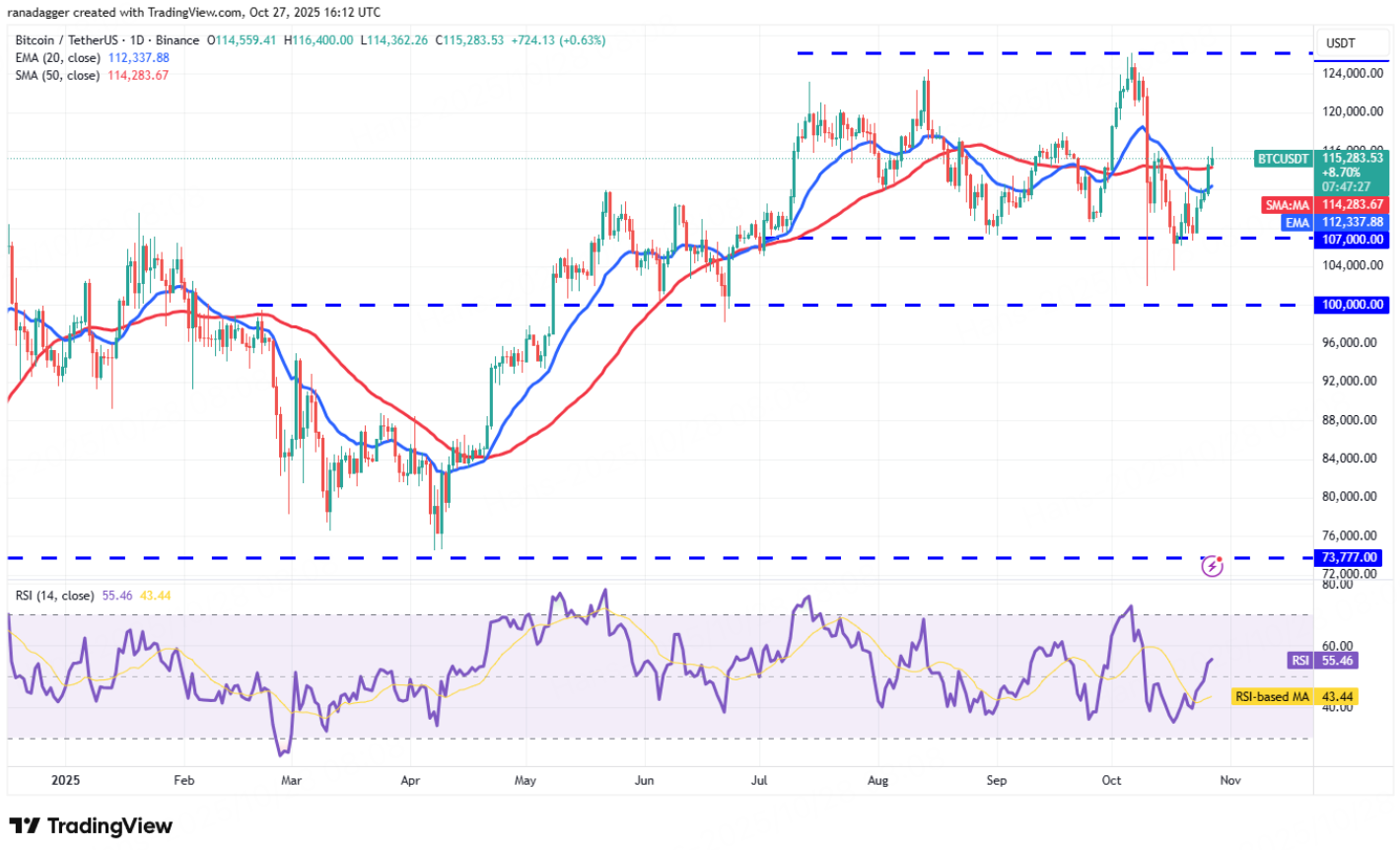
Bitcoin failed to stabilize above the 50-day simple moving average (SMA, $114,278), triggering new selling pressure and causing the price to fall back below the 20-day exponential moving average (EMA, $112,347). This indicates that short-term momentum is beginning to weaken, and market sentiment is becoming cautious. If BTC's closing price remains below the 20-day EMA, bears may further exert pressure, pushing the BTC/USDT price toward the key support level of $107,000. Bulls are expected to defend this position vigorously, as a breach of this support would confirm a "double top" pattern and could trigger a rapid decline to the psychological level of $100,000.
On the upside, $118,000 remains a significant resistance that bulls need to overcome. If the price can break through and stabilize above this level, it will release strong upward momentum, pushing BTC toward the historical high of $126,199. Before that, the market may maintain a fluctuating pattern near the moving averages, accompanied by increased short-term volatility.
ETH Price Change Analysis
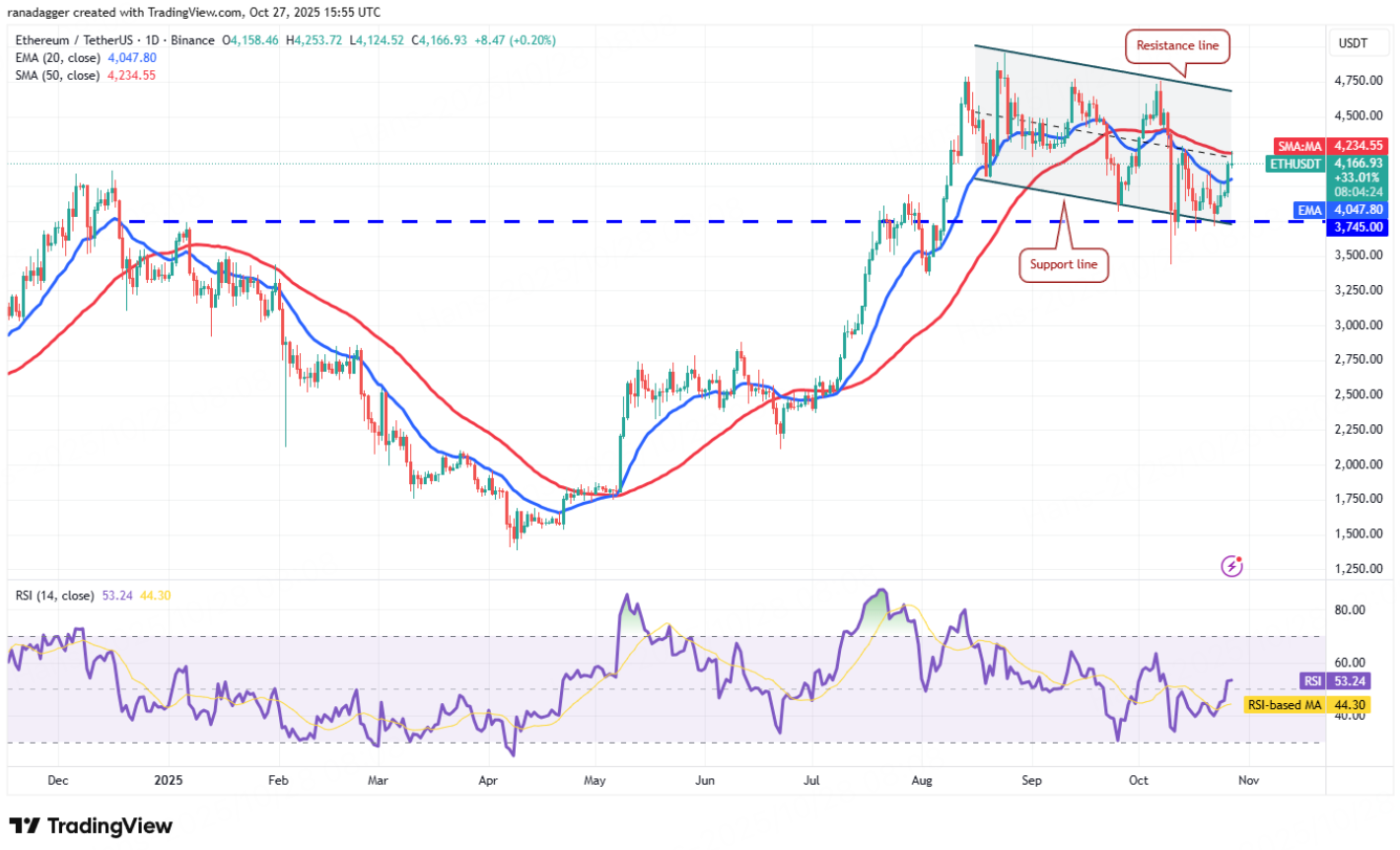
Ethereum fell again after reaching the 50-day SMA ($4,220), indicating that bears are still actively selling at high levels, and the overall trend remains weak. The current price is approaching the support line of a descending triangle, which is a key position determining the short-term direction. If this support is effectively broken, ETH/USDT may further decline to $3,350 or even lower.
If bulls can reclaim the price above the 50-day SMA, it would indicate that short-term momentum is recovering. At that point, the price is expected to rebound to the upper boundary of the descending triangle, where selling pressure is anticipated to be very strong. Only if Ethereum can successfully break through this resistance line and stabilize above it will it likely initiate a new upward trend and confirm a mid-term reversal signal.
SOL Price Change Analysis
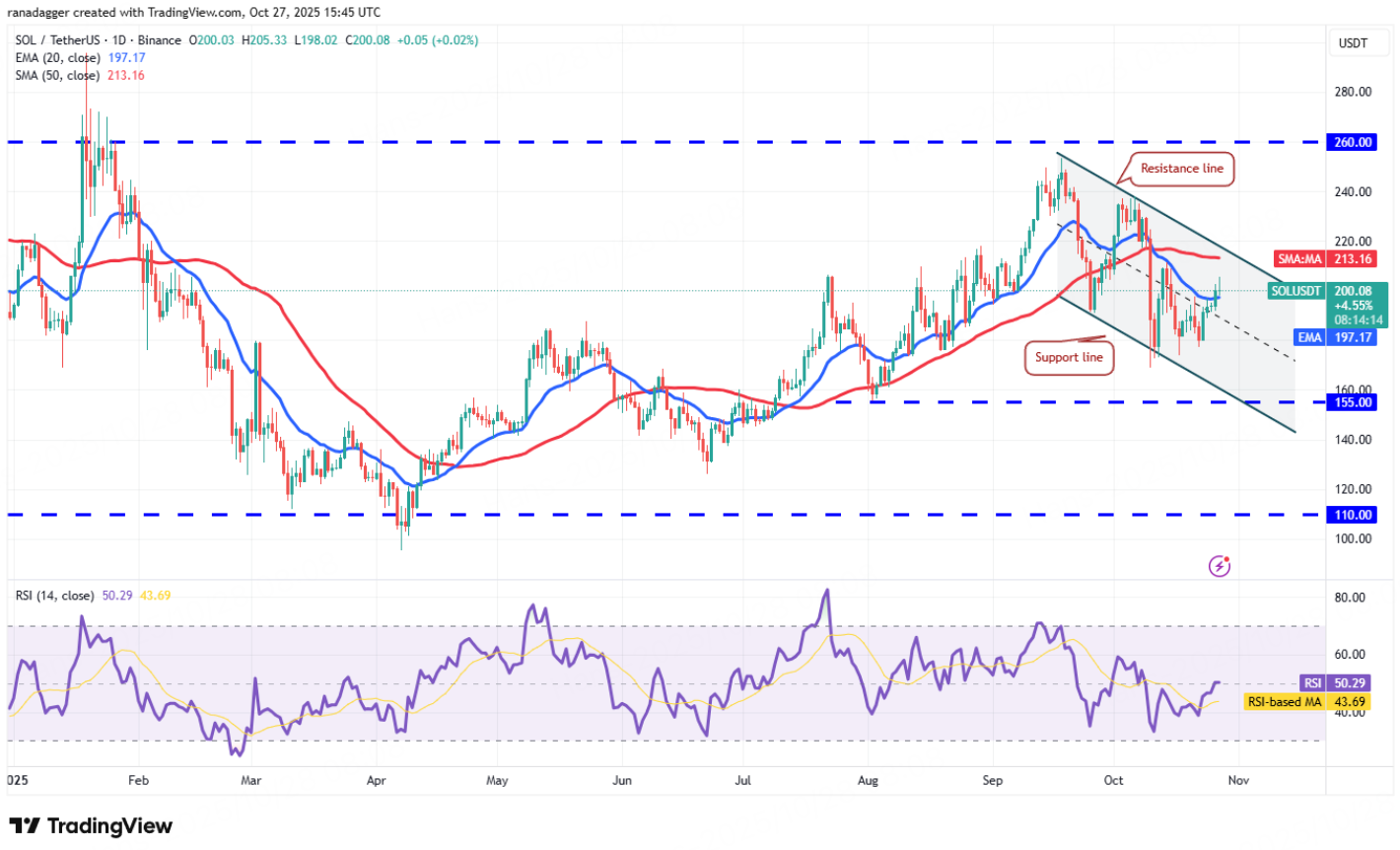
Solana briefly broke through the 20-day EMA ($196) but failed to maintain the upward momentum, indicating insufficient buying power at high levels. The current 20-day EMA is flattening, and the RSI indicator is also fluctuating near the neutral zone, suggesting a tug-of-war between bulls and bears. If buyers can push the price and close steadily above the 20-day EMA, SOL/USDT is expected to further rise to the channel resistance line. A successful breakout in this area would significantly enhance bullish expectations in the market.
Conversely, if the price falls below $190, it would indicate that bears have regained dominance. In this case, SOL may retreat to $177 and further test the lower support of the ascending channel. If support is found and stabilized here, it may indicate that funds are beginning to accumulate at lower levels; however, if support is lost, the adjustment range may expand.
5. Hot Events of the Month
Crypto Market Experiences Largest Liquidation in History, Triggered by Trump Tariffs and USDe De-pegging
On the evening of October 10, U.S. President Trump unexpectedly announced a 100% tariff on Chinese imports starting November 1, while also canceling the planned U.S.-China meeting during the Asia-Pacific Economic Cooperation (APEC) summit, leading to severe fluctuations in global financial markets. U.S. stocks initially rose and then fell, with the Dow Jones Industrial Average surging 283 points before plummeting 887 points, and the Nasdaq index dropping over 3.5%. The chain reaction in risk assets caused the crypto market to experience a violent downturn within hours, with Bitcoin dropping to $102,000 and Ethereum hitting a low of $3,392. The total liquidation amount across the network reached a historic high of $19.1 billion. According to Coinglass data, over 1.62 million people were liquidated globally, with long positions liquidating $16.7 billion and short positions nearly $2.5 billion. Altcoins were hit hardest, with many dropping over 80%, and some small tokens nearing zero. The stablecoin USDe briefly de-pegged to $0.60 on Binance before recovering to above $0.99.
This market crash was not only triggered by macro policy shocks but also revealed systemic risks due to a shortage of funds among market makers. After the collapse of Jump, market makers took on a large number of projects that were originally serviced by Jump, but with limited funds, they prioritized supporting Tier 0 and Tier 1 large projects, causing small altcoins to lose support during the market sell-off. The high-interest circular lending activities of USDe were concentrated and liquidated under extreme selling pressure, amplifying leverage and triggering a chain of liquidations, further exacerbating market panic.
Chinese Meme
In early October 2025, Binance co-founder He Yi's social media post saying "Wishing you a Binance life" unexpectedly ignited creative enthusiasm in the Chinese crypto community, giving rise to a meme coin called "Binance Life." This concept rapidly fermented through community dissemination and KOL promotion, skyrocketing to a market cap of $500 million within just a few days, with an increase of 6,000 times, creating a phenomenon. According to DeFiLlama statistics, daily trading volume on BNB chain DEX surged to $6.05 billion, attracting over 100,000 new traders.
Notably, the public chains Solana and Base, which are major hubs for meme coins, have also seen a rise in popular Chinese memes recently. Solana's official Twitter stated that its Chinese name is "Suolala," leading to the emergence of related Chinese memes. The market cap of "Base Life" on Base also surpassed ten million, and some small-cap Chinese memes have appeared on Base. It seems that from "Binance Life" to projects like "Cultivation" and "Customer Service Xiao He," Chinese memes have already established a certain position in the crypto market. With the continued expansion of the BSC ecosystem and more creators participating, it is expected that more new meme projects inspired by Chinese topics, character images, or internet hot memes will emerge.
x402 Protocol
x402 is an AI payment protocol jointly launched by Coinbase and Cloudflare, inspired by the long-unused HTTP status code "402 Payment Required." The core innovation of the protocol lies in embedding payment logic into the web interaction process, making payment an integral part of internet communication, thus forming a new model of Payment as Interaction. Through x402, AI Agents, API services, and web applications can complete instant stablecoin payments directly within standard HTTP requests. Due to its inherent support for stablecoins, small high-frequency transactions, and low latency, x402 is suitable for AI Agents to buy data, tools, and computing power on-demand, while allowing Web2 services to connect to on-chain settlements with minimal changes, eliminating the need for multiple hurdles such as registration, email, or complex signatures.
Although the x402 concept became a hot topic in the market within just two days of its launch, driving significant price increases for several related projects, with typical projects like PING seeing its price rise nearly 20 times in two days, reaching a market cap of $80 million at one point, and Payai's market cap peaking at $70 million, its popularity quickly receded after a week. Several popular projects experienced nearly 80% deep corrections from their highs. However, this concept has not faded away. With the successive launch of new tokens like Kite and Pieverse, market attention towards the x402 ecosystem is expected to be reignited.
6. Outlook for Next Month
Forecasting the Market's Entry into an Accelerated Expansion Phase
From 2024 to 2025, the prediction market sector is expected to enter a phase of explosive growth. Projects represented by Polymarket and Kalshi, the "dual leaders," continue to lead the industry, with daily trading volumes repeatedly surpassing $100 million and cumulative trading volumes reaching hundreds of billions of dollars. On the capital front, Polymarket and Kalshi have completed new rounds of financing at valuations of approximately $9 billion and $5 billion, respectively, marking a critical turning point for prediction markets as they transition from marginal innovation to mainstream financial infrastructure.
In October, Trump's media company TMTG announced its official entry into the prediction market through the Truth Social platform, launching the Truth Predict service. This will not only further expand the influence of prediction markets in U.S. politics and public opinion but may also become a milestone event in the integration of traditional social media and crypto prediction markets. Meanwhile, capital and public chain ecological layouts are also accelerating. YZI Labs invested in two prediction market projects—Opinion and Apro—this month; the prediction market protocol Limitless, co-invested by Coinbase, officially issued its token this month, currently valued at approximately $350 million. The active entry of mainstream institutions and leading ecosystems indicates that prediction markets are shifting from early "crypto niche experiments" to the next generation of financial market infrastructure centered on liquidity, compliance, and composability. Future attention should focus on the market performance of tokens from projects like Limitless, Opinion (not yet issued), and Apro, which may bring new discussion hotspots in the current market lacking popular narratives.
Market Recovery After the Black Swan Event on October 11
Since the "black swan" event on October 11, the crypto market has shown significant structural damage, and it may continue to maintain a state of high volatility and high risk in the short term. On October 30, Trump met with Xi Jinping, easing tensions between the U.S. and China; the next day, the U.S. Senate passed a resolution with 51 votes in favor and 47 against, aimed at terminating Trump's comprehensive tariff policy implemented globally. This policy change is a positive signal for the market, expected to release trade easing expectations and improve risk appetite. However, the structural damage has not been immediately repaired: although the tariff system was "voted down" by Congress, the actual implementation and the comprehensive trade agreement between the U.S. and China remain uncertain, and the policy's rollout still carries uncertainty. Additionally, the U.S. government has shut down due to budget issues, with some departments halting pay and operations, weakening fiscal spending and data transparency. The crypto market is highly dependent on macro liquidity, the strength of the dollar, geopolitical factors, and regulatory expectations, with multiple variables still in flux.
Looking ahead, if trade relations genuinely warm and drive a recovery in the real economy, it could provide a trigger point for "risk assets to return" for crypto assets; if policy implementation is delayed or new frictions arise, it could still lead to capital withdrawal and renewed market volatility. In this context, key areas to focus on include: first, the progress of U.S.-China trade negotiations and the specific timeline for tariff removal/restoration; second, the trend of the dollar, changes in the liquidity environment, especially the transmission effects of U.S. monetary and foreign exchange policies; third, the use of leverage in the crypto market and liquidation risks, as the structurally damaged environment makes passive liquidations of leverage likely to trigger chain reactions.
免责声明:本文章仅代表作者个人观点,不代表本平台的立场和观点。本文章仅供信息分享,不构成对任何人的任何投资建议。用户与作者之间的任何争议,与本平台无关。如网页中刊载的文章或图片涉及侵权,请提供相关的权利证明和身份证明发送邮件到support@aicoin.com,本平台相关工作人员将会进行核查。




